Software Outsourcing and Outstaffing: Global Talent at Your Fingertips

Outsourcing and outstaffing software services are becoming increasingly popular among businesses. After all, everyone wants to have the best software development team. Outsourcing and outstaffing are popular strategies for hiring talent from outside your company. Stick around, and let us show you how to use these strategies to your advantage.
The Difference Between Outsourcing and Outstaffing
Before you can choose between the two strategies, let us discuss each in detail.
What Is Software Outsourcing?
In outsourcing, an organization contracts with other organizations. The outsourcing team does a business function or process for the client. In this case, the business process you will outsource is software development. Organizations use these strategies when they need more resources, expertise, or time for a project. Arrangements can be short, and some partnerships end after one project.
Usually, outsourcing agencies can handle a project or business process independently. They also control the whole process using their own equipment and resources.
Here is a closer look at how software outsourcing can help you:
What Are the Benefits of Software Outsourcing?
Software outsourcing delivers a range of advantages for businesses. Read on below for some of them:
- A Global Talent Pool: Outsourcing enables firms to use global expertise. Skilled developers live around the globe, and outsourcing gives you access to all of them.
- Cost Reduction: Outsourcing allows companies to reduce overhead costs. When you’re considering how to hire developers for a startup, outsourcing becomes a strategic advantage. You will spend less money if you hire talent from remote locations with lower labor costs. Also, outsourcing development costs less than hiring employees or having an in-house team. The savings may mean the difference between profiting and being in the red for a startup.
- Access to Specialized Talent: It doesn’t matter if you have a small software development budget. With outsourcing, you can access technical experts without hiring them as full-time employees. It is an excellent strategy for companies that need a technical expert but cannot justify the expense of hiring one full-time.
- Hands-free Production: If you outsource, you can leave project management to an external team focusing on quality. The client company needs to provide only minimal project support. Also, they will have more time to focus on core competencies and strategic objectives, minus the management headache.
- Round-the-Clock Activity: In outsourcing, skilled developers work around the clock. They would be in different time zones, too. Their constant availability reduces delay and downtime. Companies that provide 24/7 services to their customers benefit from this.
- Knowledge About Industry Trends: It takes effort to gain insight into current industry trends. The easy way is to get outside expertise. In today’s world, stagnation is the enemy, and companies must keep growing. By outsourcing, companies can stay up-to-date with industry dynamics.
What Are the Types of Software Outsourcing?
There are three software outsourcing models, which vary based on distance. However, they may also involve different requirements and challenges for your company. Before you choose an outsourcing provider, read the basics about the three primary models below:
Offshore Software Development
Offshore outsourcing means that the outsourcing company is in a different country. The most significant benefit of this outsourcing model is cost savings, as labor is generally cheaper in other countries. But it also carries language barriers, cultural differences, and time zone differences. These limitations can make communication between teams more difficult.
Nearshore Software Development
Nearshore means that the outsourcing company is in a different but nearby country. This model benefits from similar time zones and language similarities. It is more cost-effective than onshore outsourcing. But it may not be as cost-effective as offshore outsourcing.
Onshore Software Development
Onshore outsourcing refers to using resources in the same country. This model allows for better communication and fewer legal and cultural issues. You also get faster turnaround times and increased project control onshore. It is usually more expensive than other models due to higher labor costs.
Companies That Outsource to Great Success
Several companies have used offshore and nearshore outsourcing effectively. These strategies have become common as they help companies save money and access specialized skills. Google, Apple, and IBM outsource business processes and outsource development. These companies have dedicated developers in other countries. Silicon Valley companies that outsource software development include WhatsApp and Cisco Systems.
Additionally, many banks and financial institutions outsource their IT department. Their outsourced teams may be from countries such as India, China, the Philippines, Mexico, Argentina, and Poland. Bank of America, JPMorgan Chase, and Citigroup work with an outsourcing agency. Some companies do not need an IT department of their own. They have a dedicated team of offshore developers.
What Is Outstaffing?
Outstaffing is like outsourcing, but it has one key difference. The client contracts with an outsourcing company to do a process in outsourcing. This process may be managing and developing software applications. In outstaffing, the outstaffing company will work with the client company’s in-house team.
Outstaffing arrangements can be more long-term compared to outsourcing. As such, you potentially have more control over production. You may be with the same outstaffing services for several projects. In outsourcing, vendors control production and use their resources. In outstaffing, the team also relies on your resources.
What Are the Benefits of Outstaffing?
Despite their differences, outstaffing has similar benefits to outsourcing. Take a look below:
- Cost Savings: Outstaffing allows you to access talented professionals worldwide. You do not need to hire permanent staff or invest in additional hardware. Outstaffing can significantly reduce overhead costs, too. It is an attractive option for startups and small businesses with limited budgets.
- Access to Global Talent: With outstaffing, companies have access to talented people who can do all the job duties online. Companies can find developers without being limited by physical location.
- Increased Project Control & Efficiency: Outstaffers assimilate with your existing team. As such, you have more control over them. This arrangement also means more efficiency and flexibility.
- New Insights Into the Industry: Knowledge about current industry trends may be unavailable locally. But outstaffed team members can provide regular insights into these trends.
- Improved Communication & Collaboration: Outstaffers work closely with your in-house team. They must also follow your processes and channels. You can directly talk to outstaffers and instruct them. In contrast, you usually communicate with only one or two contact persons in an outsourced team, such as the project manager or a liaison.
What Are the Types of Outstaffing?
Just like in outsourcing, outstaffing has various models. Here are the basics.
Dedicated Development Team
A dedicated team is a developer team that exclusively works for software companies. The group provides skills and expertise to your company. In this arrangement, you have more control over software development budgets. With a dedicated team, communication is open. This openness makes collaboration between a third-party company and your in-house teams seamless.
Moreover, the hirer controls the strategy, management, scheduling, and development process. In this model, you can also decide how many experts should work on specific tasks. They will report directly to you while working under your guidance.
Staff Augmentation
In this other outstaffing model, you hire specialists who join your existing teams temporarily. They can be part-time or full-time, depending on your needs. This model grants businesses access to talented professionals without directly employing them. Companies benefit from lower costs associated with contract workers than traditional employees. Still, there may be some tradeoffs. Some individuals leave midway through a project, resulting in continuity issues and new hiring costs.
Extended Development Team
An extended team is a team for larger projects that requires a longer commitment. Your partnership with the outsourcing company may last years, depending on what you want or need. Outsourcing providers of this type have their very own teams and resources. As such, they can start immediately, saving precious time and money.
Companies That Outstaff
Many prominent American companies have turned to the outstaffing model. This model allows them to access specialized skills, reduce costs, and increase efficiency. Google is a famous example. According to Forbes, they had more contractors than employees in 2019. By partnering with outstaffing companies, they could achieve their business goals.
Now that you know how these strategies can benefit you, you can learn how to apply them to your business.
The Process of Software Outsourcing and Outstaffing
The whole process can be short or long. The length will depend on your arrangements and how long the entire project will last.
Steps to Success in Software Outsourcing and Outstaffing
Since businesses have different needs and resources, there is no one-size-fits-all, cookie-cutter procedure. That said, here is how the process generally goes:
1. Define project scope and requirements.
As a business owner or manager, you must know the project scope and requirements before making any commitments. Doing so keeps stakeholders on the same page and lets you set clear expectations. By determining your project’s scope and needs upfront, businesses can choose the most suitable outsourcing model.
2. Identify the right outstaffing or outsourcing agency.
Once you’ve defined the project scope and requirements, it’s time to find the right software development service provider. Here are some tips on how to do this:
- Look up outsourcing companies and outstaffing services specializing in your field, or get the help of a hiring company.
- Look at prospects’ portfolios, expertise, and experience with similar projects.
- Get experienced developers with references from previous customers.
Once you’ve settled on a few possible providers, contact them and set up an initial meeting (or virtual call) to discuss the project further. Make sure to look at their cost to get value for your investment. In addition, if you are getting a dedicated software development team, look for one with similar values and goals. Your shared values ensure a successful and collaborative partnership.
3. Create a project plan and timeline.
Once you have chosen an outsourcing company, you need a plan and a timeline. Creating a timeline for any software development project is essential. Doing so ensures you keep the project on track and see it through. A timeline helps you meet deadlines and achieve milestones. It also helps to identify potential problems early on, giving you enough time to make adjustments or changes before it’s too late.
There are many ways to make a timeline, but the easiest way is to use project timeline software. This type of software helps to create a visual timeline, track progress, and provide an overview of the project.
4. Establish effective communication and project management.
Once you have a timeline, you must manage the project and ensure things go smoothly. Establishing clear and consistent communication channels is critical. They allow you to outline the strategy for your chosen outsourcing company. In addition, consider adopting the Agile development methodology.
In Agile software development, you break the project into smaller tasks and build software through rapid, short iterations. This method foregoes trying to deliver one product at the end. Instead, developers focus on increasing value in small additions throughout the project. This way, the project experiences less disruption and more efficiency. Overall, this approach helps project development move quickly and stay within budget.
Role Models for Remote Management and Outsourcing
Many companies use software development outsourcing. The most noteworthy ones are Basecamp and GitHub.
Basecamp is a company that makes software for managing projects and collaborating. The company’s valuation varies — its CEO, Jason Fried, has a rock-solid stance against valuation. Basecamp employes outstaffed teams and outsources software projects. The company now serves over 3.5 million users worldwide despite having remote teams. To achieve this, Basecamp uses an asynchronous communication model. Its remote team members can work from anywhere at any time. In this system, constant communication is unnecessary. Each person documents their contributions to the development process on the fly.
GitHub is another example of a successful organization that has managed remote teams. The company’s remote management strategy revolves around transparency, collaboration, and trust. With these values, GitHub fosters open communication and inclusivity among its remote developers.
The tips below come right out of Basecamp’s and GitHub’s playbook. Take a look!
Remote Team Management Strategies and Tips
Managing an external team overseas comes with its own unique set of challenges. An in-house team requires a specific communication, management, and collaboration approach. On the other hand, a remote team requires a different approach. To ensure that your off-site group is successful, here are some tips on how to manage one effectively:
- Check in regularly. Schedule regular formal and informal check-in meetings. These meetings keep your team on track and allow them to ask questions or provide feedback. Check-ins are vital in remote team management.
- Encourage open communication. Make your team members feel comfortable enough to open up. They should talk openly with each other throughout the development process. You can use Slack channels, video conferencing, email threads, and other methods.
- Delegate tasks appropriately. Delegate tasks effectively to keep developers on the same page.
- Provide clear expectations. Set clear goals and expectations for your remote team members. That way, everyone knows what you expect from them and when you expect it.
- Build trust. Create an environment of trust between team members. Allow them to work independently and provide regular feedback. Also, recognize them for a job well done.
- Use collaboration tools. Collaboration tools help keep everyone on the same page. You can use these throughout the development process. These include management software, video conferencing platforms, and document-sharing services.
The Advantages and Challenges of Software Outsourcing and Outstaffing
Both outsourcing and outstaffing have similar benefits. Here are the advantages of outsourcing software development:
- Cost savings
- Access to specialized talent
- Flexibility and scalability
- New insights into industry trends
- Round-the-clock activity
For many companies, outsourcing and outstaffing lead to massive savings. For example, Apple outsources to Foxconn to save on costs. Intel has also successfully used outstaffers for some of its software development and other tasks. Intel has announced plans to outsource chip production, too.
What Makes Outsourcing and Outstaffing Hard
Like with any plan, there are challenges associated with outsourcing software development. Read about the challenges that come with outstaffing and outsourcing.
- Language and cultural barriers – Countries have different cultures. So, team members may have varying work values or habits. Manage communication issues effectively to ensure successful collaboration.
- Distance and time zone differences – Working with outsourced developers or an outstaffing team in a different time zone is hard. Scheduling meetings at times that are convenient for both parties can mitigate this.
- Security and privacy concerns – Every outsourcing or outstaffing model comes with security issues. Vet every service provider. By doing so, you can ensure that they adhere to industry standards and that data is secure.
- Compromised quality of work – Quality is one of the biggest challenges of outsourcing. After all, you don’t have complete control over the development team members working on the project. One option is to impose quality requirements. Still, you have no direct impact on their processes and procedures. Moreover, they may change their process and cause longer production times. Your remote managers must focus on quality.
- Intellectual property protection – Working with third parties makes protecting your company’s intellectual property rights challenging. Software providers should have contracts outlining both parties’ expectations and protections.
Outsourcing and Outstaffing’s Unique Obstacles
Outsourcing comes with a different set of challenges than outstaffing. In outsourcing, your agreement with your software outsourcing partner dictates everything. Even though there is room for negotiation, it takes more effort to enact change. Also, the results can take longer to manifest since you do not control the outsourced team’s process.
In contrast, outstaffing requires more effort from your end. While the outstaffed team may not need as much training as in-house employees, you must still acquaint them with processes. In other words, you must help them assimilate. You may also need to provide their equipment, which means more expenses and more time to start up.
Lastly, suppose you have remote employees. You have probably encountered issues such as low productivity and aloofness with them. You’ll face these same issues with remote outstaffers.
Choosing the Right Partner in Outsourcing
Finding the right software outsourcing partner can take time and effort. There are numerous providers, each with its strengths and weaknesses. Carefully research your options before making any commitments to ensure you get the most value for your investment.
The Ideal Qualities of an Outsourcing Partner
Here are some things you should consider.
1. Technical Expertise
When selecting an outsourcing agency or outstaffing company, look at its technical expertise. Your hired developers should have a wealth of experience in custom software development. This expertise should cover the entire software development process and life cycle. Also, they must guide the process through ideation, prototyping, design, and implementation. A software developer should know programming languages like Python, JavaScript, and more. With this under their belt, you can be confident they can cater to your company’s needs.
2. Communication and Management Skills
In outsourcing and outstaffing, communication and management skills are essential. The software development process is complex. It requires oversight and excellent communication between all parties involved.
3. Cultural Fit
Cultural fit is an essential factor when selecting a software development service provider. Working with a partner that shares your company’s values and goals can make collaboration smoother. A good relationship matters, especially since the development process can take months or years. When teams share the same culture and values, they work together more effectively as they have shared mindsets. Cooperation reduces misunderstandings and helps build trust between the two parties. Suppose your in-house software development team could adjust to cultural differences easily. In that case, choosing between a nearshore development center and an offshore development center will be easy.
Questions To Ask Prospective Partners
When finding the right partner, you should take every step to know more about them. That way, you can assess whether you will work great together. During your meetings, ask questions to learn more about the prospective partners. Ask questions such as:
- How do you ensure quality and timely delivery?
- What is your approach to project management?
- How do you handle communication and collaboration?
- What security protocols do you have in place to protect our data?
- How do you handle customer support issues and requests?
Tips for Negotiating Contracts and Managing Relationships
Once you have chosen a partner to make a deal with, you must negotiate a software outsourcing contract with them. Also, you must maintain a good relationship. Here are some tips for doing that:
- Define clear terms. When negotiating a contract with an outsourcing company, you must define the agreement terms in detail. Define the scope of work, timelines, deliverables, budget, and other relevant information. Ensure all parties agree on expectations and clearly outline their roles and responsibilities. Outline your goals and how you plan to achieve them together.
- Establish a regular communication plan. Try to keep all parties informed. A plan will help maintain that. You need to know the progress of the whole project, any potential issues, and whole project support. Schedule regular meetings, emails, or video calls with your teams.
- Respect cultural differences. Different cultures have different ways of doing things. Be considerate of cultural differences and be open to learning new things from each other. Respect helps create a strong working relationship between both parties.
Conclusion
Outsourcing and outstaffing are excellent strategic decisions. They allow businesses to access specialized skills and keep costs low. With these strategies, companies can scale and tailor their projects as required. Companies also gain advanced insights into market trends in the bargain.
That said, these approaches are associated with numerous challenges. Cultural differences and quality control are some of the biggest concerns in outsourcing. Also, look out for security, privacy, and intellectual property rights matters. Businesses should choose a partner who is an excellent cultural fit. They must be technical experts, excellent communicators, and skilled managers.
With software development outsourcing, businesses can compete on the global stage. Use outsourcing and outstaffing resources to get the most out of every effort. Act now to take your business to the next level, beyond borders – don’t miss the opportunity!
We’re BIT Studios!
At BIT Studios we specialize in designing, building, shipping, and scaling beautiful, usable products with blazing-fast efficiency



